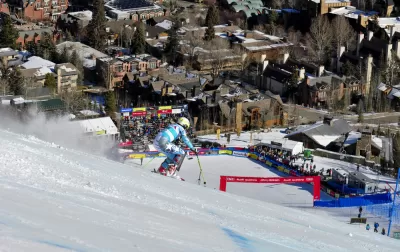The Aspen Ideas Festival didn't offer much that was particularly compelling, but it had its moments.

The Aspen Idea Festival's 2014 edition offered nothing that we haven’t heard before, if the short video featured in this recent CityLab story is any indication. Several "Leading Voices" in today's conversation about cities were asked this "Big Question": What’s the Number One Thing We Could Do to Improve City Life?
Geoffrey West says it's time to recognize the prominence of cities and urban life in the future of the planet. Alissa Walker says we need to make cities more walkable. Jeff Speck says we need to "restripe" cities to make them more "equitable" for cars and pedestrians. Jennifer Pahlka says we need to get cars out of cities altogether and develop better mass transit. M. Sanjayan says we need better ways to connect city-dwellers back to nature.
None of this is all that inspiring on the face of it. One persistent commentator spares no snark in offering this assessment:
I don't care what self-entitled, privileged people who go to events like TED or Aspen Institute think. They are not more important or interesting because they are there…Oh, and Mr. Sanjayan, it's called houseplants. People who live in cities actually grow plants in their houses on windowsills, tables and in windowboxes. How about that? Some even have yards where they live…The ONE thing that is needed is affordable housing for every class of people in their neighborhoods or where they need to live. That is more important than free bicycles, gardens, parks, or anything else.
The last point about affordable housing is a recommendation that's more compelling than any offered by the Leading Voices featured in the video. However, embedded in the video are a few excellent observations that might generate more creative thought about what’s needed for urban improvement beyond what we’re already investing in the area of transportation. These observations might also allow us to better address our commentator's (and this blog's) expressed concern for social and cultural equity.
Luís Bettencourt argues that cities "enable the mixing of people and organizations, interactions that can be generative of new things, of better things." How might public space (including urban parks) and housing (including housing for the homeless) be better designed and located so as to encourage such fruitful mixing across lines of class and culture?
Geoffrey West says we need to "engage citizens" and help them "understand what it is we’re trying to accomplish." Leveraging modern technology is one way to engage citizens. But there’s certainly much more that can be done to further the collective enterprise of city building via more prosaic technologies like sticky notes, white boards, and billboards.
Finally—and perhaps most significantly—M. Sanjayan notes that "we lived on the plains of East Africa for millions of years" before we became "city worthy." What would an agenda for improving city life look like if we checked our presentism and took the deep, pre-urban history of humankind a bit more seriously as a source of ideas? And, if we considered the lessons taught by urban phenomena with which scholars and planners are much less familiar? Such comparative exercises might expand and enrich our understanding of city life and the variety of ways that humans have dealt with its many challenges.

Manufactured Crisis: Losing the Nation’s Largest Source of Unsubsidized Affordable Housing
Manufactured housing communities have long been an affordable housing option for millions of people living in the U.S., but that affordability is disappearing rapidly. How did we get here?

Americans May Be Stuck — But Why?
Americans are moving a lot less than they once did, and that is a problem. While Yoni Applebaum, in his highly-publicized article Stuck, gets the reasons badly wrong, it's still important to ask: why are we moving so much less than before?

Using Old Oil and Gas Wells for Green Energy Storage
Penn State researchers have found that repurposing abandoned oil and gas wells for geothermal-assisted compressed-air energy storage can boost efficiency, reduce environmental risks, and support clean energy and job transitions.

Greening Oakland’s School Grounds
With help from community partners like the Trust for Public Land, Oakland Unified School District is turning barren, asphalt-covered schoolyards into vibrant, green spaces that support outdoor learning, play, and student well-being.

California Governor Suspends CEQA Reviews for Utilities in Fire Areas
Utility restoration efforts in areas affected by the January wildfires in Los Angeles will be exempt from environmental regulations to speed up the rebuilding of essential infrastructure.

Native American Communities Prepare to Lead on Environmental Stewardship
In the face of federal threats to public lands and conservation efforts, indigenous groups continue to model nature-centered conservation efforts.
Urban Design for Planners 1: Software Tools
This six-course series explores essential urban design concepts using open source software and equips planners with the tools they need to participate fully in the urban design process.
Planning for Universal Design
Learn the tools for implementing Universal Design in planning regulations.
Heyer Gruel & Associates PA
City of Moreno Valley
Institute for Housing and Urban Development Studies (IHS)
City of Grandview
Harvard GSD Executive Education
Salt Lake City
NYU Wagner Graduate School of Public Service
City of Cambridge, Maryland




























